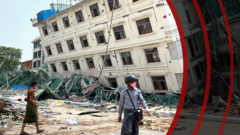
Myanmar Grapples with Devastation Following Powerful Earthquake
International Aid Efforts Underway as Nation Assesses Damage
Myanmar is reeling from the aftermath of a significant earthquake that struck the already volatile nation. The quake, felt across multiple regions, has caused widespread damage to infrastructure and homes, exacerbating the challenges faced by communities already struggling with ongoing conflict.
Extent of the Damage
Reports are still emerging from affected areas, but early indications suggest a considerable scale of destruction. Communication lines have been disrupted in many regions, hindering efforts to fully assess the extent of the damage. Preliminary assessments point to significant damage to:
- Residential Buildings: Numerous homes have been rendered uninhabitable, forcing residents to seek shelter elsewhere.
- Infrastructure: Roads, bridges, and power lines have sustained damage, impeding rescue and relief efforts.
- Healthcare Facilities: Hospitals and clinics, already strained by existing needs, have been further impacted, limiting their capacity to provide care.
The earthquake's impact is particularly concerning in areas already affected by armed conflict. The combination of natural disaster and ongoing instability presents a complex humanitarian challenge.
Humanitarian Response
In the wake of the disaster, local organizations and international aid agencies have mobilized to provide assistance to affected communities. The immediate priorities include:
- Providing emergency shelter and essential supplies, such as food, water, and blankets.
- Delivering medical care to the injured and those in need of urgent medical attention.
- Clearing debris and restoring access to affected areas.
- Assessing the long-term needs of the affected population and developing sustainable recovery plans.
Challenges remain in reaching all those in need, particularly in remote and conflict-affected areas. Access restrictions and logistical hurdles are complicating the delivery of aid.
Geopolitical Context
The earthquake struck Myanmar at a time of heightened political and social instability. The ongoing conflict between the military junta and various ethnic armed groups has created a complex and precarious environment. The natural disaster further compounds these challenges, adding to the suffering of the civilian population.
The international community is closely monitoring the situation and urging all parties to ensure unhindered humanitarian access to affected areas. The provision of aid must be guided by principles of neutrality, impartiality, and humanity, ensuring that assistance reaches those who need it most, regardless of their ethnicity, religion, or political affiliation.
Long-Term Recovery
The road to recovery for Myanmar will be long and arduous. Beyond the immediate needs of providing emergency relief, there is a need for comprehensive and sustained support to rebuild damaged infrastructure, restore livelihoods, and address the underlying causes of vulnerability.
International cooperation and coordination will be essential to ensure that recovery efforts are effective and sustainable. This includes providing financial assistance, technical expertise, and capacity-building support to local communities and organizations.
Looking Ahead
The earthquake serves as a stark reminder of the vulnerability of Myanmar to natural disasters. Building resilience to future shocks will require a multi-faceted approach, including investing in disaster preparedness, strengthening infrastructure, and promoting sustainable development.
The international community must stand in solidarity with the people of Myanmar during this difficult time and provide the support they need to rebuild their lives and communities.
```